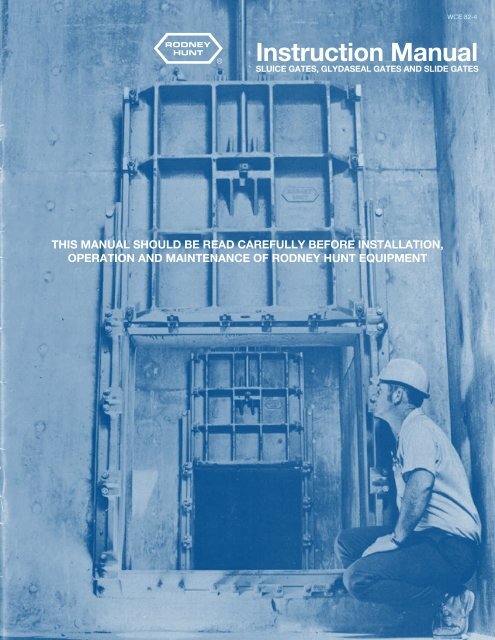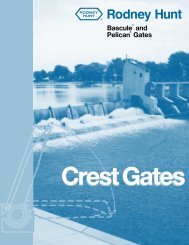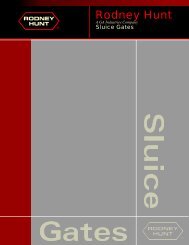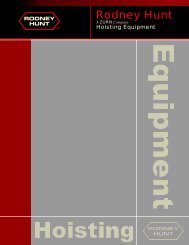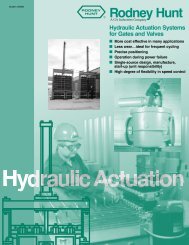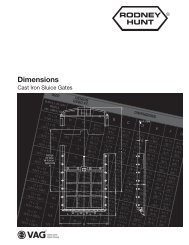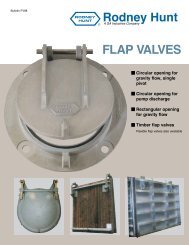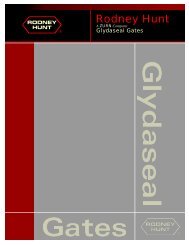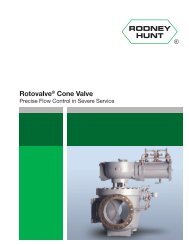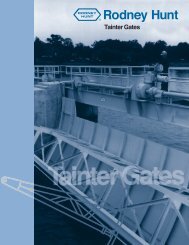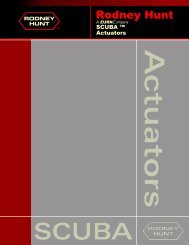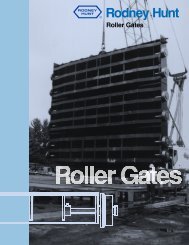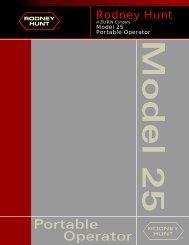Instruction Manual - Rodney Hunt Company
Instruction Manual - Rodney Hunt Company
Instruction Manual - Rodney Hunt Company
You also want an ePaper? Increase the reach of your titles
YUMPU automatically turns print PDFs into web optimized ePapers that Google loves.
THIS MANUAL SHOULD BE READ CAREFULLY BEFORE INSTALLATION,<br />
OPERATION AND MAINTENANCE OF RODNEY HUNT EQUIPMENT<br />
WCE 82-4<br />
<strong>Instruction</strong> <strong>Manual</strong><br />
SLUICE GATES, GLYDASEAL GATES AND SLIDE GATES
TABLE OF CONTENTS<br />
Page<br />
Introduction ..................................................................3<br />
Handling and Storage ..................................................4<br />
Sluice Gate Installation .................................................6<br />
Hy-Q Sluice Gate .......................................................10<br />
Conventional Sluice Gate ...........................................11<br />
Field Adjustment ........................................................12<br />
Glydaseal Gates .........................................................14<br />
Slide Gate Installation ................................................18<br />
Operating Mechanisms ..............................................19<br />
Pipe Covers, Indicators ..............................................21<br />
Stems and Stem Guides ............................................22<br />
Operating Sluice Gates ..............................................23<br />
Operating Slide Gates ................................................24<br />
Trouble Shooting Tips, Sluice Gates ..........................25<br />
Trouble Shooting Tips, Slide Gates ............................28<br />
Maintenance ...............................................................29<br />
General Notes ............................................................30<br />
Field Service Policy .....................................Back Cover<br />
Copyright 1979<br />
<strong>Rodney</strong> <strong>Hunt</strong> <strong>Company</strong><br />
Orange, Massachusetts<br />
The information herein is, to our knowledge, true and accurate However, <strong>Rodney</strong> <strong>Hunt</strong><br />
<strong>Company</strong> makes no warranties or representation, expressed or implied, other than those<br />
set forth in the specifications or a formal quotation. No agent, representative or employee<br />
of this company is authorized to vary the terms of this notice
Introduction<br />
This manual describes the recommended methods of<br />
installation, adjustment, initial operations, maintenance<br />
and safety precautions for <strong>Rodney</strong> <strong>Hunt</strong> sluice gates,<br />
slide gates, operating mechanisms and related equipment.<br />
It should be used in conjunction with approved<br />
drawings provided by the <strong>Rodney</strong> <strong>Hunt</strong> <strong>Company</strong>.<br />
The information in this manual pertains to most <strong>Rodney</strong><br />
<strong>Hunt</strong> gates. However, there are special installations<br />
which require more specific information. In these cases<br />
a special set of instructions is forwarded to the gate user<br />
before installation.<br />
<strong>Rodney</strong> <strong>Hunt</strong> sluice gates have been designed and manufactured<br />
to result in a nearly watertight closure. Before<br />
leaving the <strong>Rodney</strong> <strong>Hunt</strong> plant, equipment is inspected<br />
and the gate wedges are properly adjusted.<br />
This installation drawing is typical of many sent to the contractor long<br />
before sluice gates are cast.<br />
These precautions result in gates with low leakage characteristics.<br />
However, great care must be used in the<br />
handling, storage and installation of <strong>Rodney</strong> <strong>Hunt</strong> sluice<br />
gates to insure that they will operate as designed, and<br />
with maximum watertightness.<br />
<strong>Rodney</strong> <strong>Hunt</strong> slide gates have also been designed and<br />
manufactured to meet your specific requirements.<br />
The information in this manual is intended only as a recommendation<br />
for the proper and satisfactory installation<br />
of our equipment. <strong>Rodney</strong> <strong>Hunt</strong> <strong>Company</strong> assumes<br />
no liability, expressed or implied, for the interpretation<br />
of the recommendations or the faulty installation of the<br />
gates. Its responsibility is limited to defects in manufacturing<br />
rather than installation, adjustment and related<br />
problems subsequent to manufacturing.<br />
Special instruction manuals for intricate systems and components<br />
are also prepared for the contractor.<br />
3
Handling and Storage<br />
For Safety<br />
To prevent personal injury or equipment damage,<br />
follow standard safety procedures when handling<br />
equipment and be sure rigging equipment is properly<br />
placed and in safe working condition.<br />
Although <strong>Rodney</strong> <strong>Hunt</strong> sluice gate equipment is durable<br />
and heavily constructed, there are precision-machined<br />
seat and wedge facings which require a great deal<br />
of attention and care when being installed. Stem<br />
threads and hoists have precision surfaces that should<br />
be protected from damage.<br />
Sluice gates are provided with locking plates to hold the<br />
disc firmly in place in the guides during shipping and<br />
installation. Gates can be lifted by a chain or sling<br />
Locking plates are positioned above the disc or between the disc<br />
and guide on either side of the frame.<br />
4<br />
through the stem hole in the disc only when locking<br />
plates are in place. Locking plates have been designed<br />
to withstand normal lifting stresses. When lifting<br />
gates, take special care to protect machined surfaces<br />
and wedges. Locking plates must be removed before<br />
opening gate.<br />
Equipment should be stored on planks or timbers over<br />
an even surface to keep them off the ground and to<br />
prevent distortion. Equipment should also be covered<br />
Sluice gate is properly lifted by the stem hole in the disc as long as<br />
locking plates are in place.
to protect seat facings and other machined surfaces<br />
from foreign matter. Where there are a number of medium<br />
or small gates and where storage space is limited,<br />
it may be necessary to stack the gates. Sluice gates<br />
should not be stacked more than three high, and then,<br />
only with heavy timber blocking placed between the<br />
gates to prevent damage to gates.<br />
To prevent bending when lifting, handling and storing,<br />
stems should be supported over their full length. They<br />
Note how stem is<br />
carefully supported<br />
when lifted.<br />
Gates and Hoists stored at the construction site awaiting installation.<br />
should be stored carefully only on an even surface in<br />
a clean, dry area. The threaded portion of the stem is<br />
protected by a heavy fiber cover which should not be<br />
removed until the stem is ready for installation. Couplings<br />
and thrust nuts are shipped in place on the stems<br />
and should be removed prior to installation. Stop collars<br />
are normally shipped in a bag or box accompanying the<br />
floor stands. Operating mechanisms should be handled<br />
and treated as precision machinery and protected accordingly.<br />
Refer to page 29.<br />
Stems are supported evenly<br />
and kept off the ground.<br />
5
Installation Items Embedded in Concrete<br />
The most important single aspect of a sluice gate installation<br />
is the correct placement of the embedded<br />
items in the concrete. If these embedded items are accurately<br />
and carefully located and held in place during<br />
the concrete pour, a proper sluice gate installation is<br />
practically assured.<br />
A careful embedment of wall thimbles in concrete is an essential<br />
first step in a proper gate installation.<br />
6<br />
WALL THIMBLES<br />
1. The front face of all <strong>Rodney</strong> <strong>Hunt</strong> thimbles . . . .rectangular,<br />
square and circular . . . . are marked on vertical<br />
and horizontal centerlines. The centerline marks are also<br />
placed on the outer edge of the mounting flange of the<br />
wall thimble so that they can be seen after the thimbles<br />
are bolted to the forms.<br />
2. Wall thimbles should be set with the top mark up and<br />
top and bottom centerline marks plumb.<br />
3. After being set at the proper elevation, the wall thimble<br />
must be internally braced to carry the weight of<br />
the concrete. Care should be used in placement of the<br />
braces so as not to distort the wall thimble. Gate attaching<br />
holes and hardware will be misaligned if the wall<br />
thimble is distorted.<br />
4. The wall thimble should be firmly supported on the<br />
form. The studs and nuts furnished with the thimble can<br />
be used for bolting the thimble in place. Forms should<br />
be supported and stiffened against movement. If forms<br />
move they will distort the wall thimble mounting flange,<br />
and the sluice gate will leak.<br />
Every <strong>Rodney</strong> <strong>Hunt</strong> wall thimble is shipped with a centerline scribe<br />
on its front face and top edge before leaving the factory. The top of<br />
the thimble is clearly marked. In this way, thimbles can be mounted<br />
and aligned quickly into position during installation.
5. The tapped holes in the face of the wall thimble must<br />
be plugged or capped to prevent concrete from entering<br />
the holes. <strong>Rodney</strong> <strong>Hunt</strong> furnishes wall thimbles with<br />
plastic caps in the ends of each tapped hole. These caps<br />
should be left in place until the thimble is cast in the concrete<br />
and the gate is prepared for installation. The caps<br />
are easily removed by puncturing with a screw driver.<br />
6. Where the depth of the wall thimble and thickness<br />
of the wall are the same, care is taken to maintain the<br />
length of the thimble within acceptable tolerances. This<br />
prevents distortion of the forms or the necessity of<br />
blocking the area between the casting and the forms.<br />
7. After the concrete has hardened and the forms removed,<br />
the front surface of the wall thimble should be<br />
thoroughly cleaned. Make sure to remove any concrete<br />
that has flowed onto the surface from the edges. Care<br />
should be taken to prevent damage to machined surfaces.<br />
The front flange of each <strong>Rodney</strong> <strong>Hunt</strong> wall thimble<br />
is purposely oversized to minimize this problem.<br />
ANCHOR BOLTS<br />
Anchor bolts may be furnished for mounting gates, supporting<br />
the upper gate guides, or mounting stem guides<br />
and hoists. The location and projection of the anchor<br />
bolts are shown on the installation drawing. Anchor bolts<br />
should be placed in the holes drilled in the forms at locations<br />
indicated on the drawings. The hook ends of the<br />
anchor bolts should then be wired to the opposite form<br />
or to reinforcing rods to hold the bolts firmly in place.<br />
Typical anchor bolt configuration.<br />
<strong>Rodney</strong> <strong>Hunt</strong> wall thimbles are furnished with plastic cap plugs in the<br />
mounting holes to prevent damage to threads and to keep concrete<br />
out of the holes.<br />
7
Sluice Gates<br />
A sluice gate should be set on wall thimble studs or anchor<br />
bolts as a complete un it. It is essential that the gate<br />
disc be firmly wedged in the closed position so that the<br />
unit will be held rigid to prevent distortion. The sluice<br />
gate can be lifted by the stem hole in the disc only when<br />
the locking plates are in place. In this way, the gate will<br />
hang nearly vertical.<br />
Gates, properly stacked, await installation on a construction site.<br />
Sluice gates leaving <strong>Rodney</strong> <strong>Hunt</strong> are well secured and protected<br />
against in-transit damage.<br />
8<br />
INSTALLATION ON WALL THIMBLES<br />
1. The face of the wall thimble should be thoroughly<br />
cleaned and all wall thimble studs in place. Care should<br />
be taken to prevent damage to machined surfaces. The<br />
plastic plugs in the bolt holes are easily removed by<br />
puncturing with a screwdriver.<br />
2. A gasket should be provided between the surface of<br />
the wall thimble and the mounting flange of the sluice<br />
gate. A butyl rubber mastic is normally supplied with<br />
<strong>Rodney</strong> <strong>Hunt</strong> gates for this purpose and should be applied<br />
in accordance with the label directions.<br />
3. If gasket material other than mastic is used, it should<br />
be installed over the studs to provide a smooth mounting<br />
surface for the gate. If the gasket is other than one<br />
piece, the dovetailed gasket joints should be aligned<br />
in accordance with the match markings and cemented<br />
with a liquid-type gasket material. When applying gasket<br />
materials, care should be taken to ensure that excessive<br />
amounts of lumpy, dried materials are not present when<br />
the sluice gate is drawn tightly to the wall thimbles.<br />
4. The mounting flange of the sluice gate should be thoroughly<br />
cleaned. Care should be taken to prevent damage<br />
to machined surfaces.<br />
5. The gate can then be lifted and set over the studs,<br />
and nuts put in place and tightened. The sequence of<br />
tightening should be as indicated in the drawings below.<br />
Nearly equal torque should be applied to all nuts so that<br />
the gate is firmly and evenly tightened to the mounting<br />
flange without distortion.<br />
RECTANGULAR OR<br />
SQUARE OPENING<br />
SLUICE GATE<br />
CIRCULAR OPENING<br />
SLUICE GATE<br />
INSTALLATION WITH ANCHOR BOLTS<br />
Where sluice gates are mounted on anchor bolts it is<br />
recommended that 1” of grout be placed between the<br />
mounting flange of the gate and the concrete wall. The<br />
projection of the anchor bolts shown on the installation<br />
drawings includes provisions for this 1” of grout.
1. All anchor bolt threading should be checked to make<br />
sure that threads are undamaged.<br />
2. The gate should be lifted and put in place over the<br />
anchor bolts. Attach nuts.<br />
3. Shims should be placed between the back flange of<br />
the sluice gate and the concrete wall in sufficient number<br />
so that the gate will be plumb and flat and can be<br />
firmly tightened against the shims without distortion.<br />
4. With the gate flange located approximately 1” from<br />
the wall, a non-shrink grout should be placed between<br />
the flange and the concrete wall.<br />
5. After the grout has hardened, the shims can be removed<br />
and the nuts further tightened so that the gate is<br />
firmly in place against the grout.<br />
UPPER GATE ANCHOR BOLTS<br />
1. Embedded anchor bolts required to support the upper<br />
gate guides must be positioned in forms at the time the<br />
concrete is poured.<br />
2. These anchor bolts are provided with double nuts so<br />
that upper gate guides can be firmly clamped in position.<br />
The back-up nuts must be placed on the anchor<br />
bolts before the gate is installed.<br />
The gate should not be bolted directly to an uneven<br />
surface. Even a very small amount of gate distortion<br />
will cause excessive leakage.<br />
INSTALLATION ON PIPE FLANGES<br />
1. Where sluice gates are mounted on cast-iron pipe<br />
flanges, the procedure is the same as when the gate is<br />
mounted on a wall thimble.<br />
2. Where the gate is being mounted on a steel flange<br />
that has been welded to a pipe or adaptor, the front surface<br />
of the pipe or adaptor will not be sufficiently flat<br />
unless it has been machined after welding.<br />
A. The gate should be bolted loosely to the flange so that<br />
surfaces touch. Be sure that neither surface is distorted.<br />
A feeler gauge should be used to check the clearance<br />
completely around the periphery of the gate.<br />
B. Leakage may occur if the distortion is more than<br />
0.010 when the two surfaces are bolted together.<br />
C. By using a thick fibrated mastic between surfaces,<br />
it may be possible to prevent leakage between flanges.<br />
In no case should the gate flange be firmly tightened<br />
against a flange that is not flat.<br />
D. If the spacing is very large, the gate should be<br />
shimmed a small distance away from the flange. Space<br />
between the flanges can be caulked with non-shrink<br />
epoxy grout. This will allow the gate to be tightened to<br />
the steel flange without distortion or leakage between<br />
the flanges.<br />
Consult the factory for assistance if the flange on which<br />
the gate is to be installed is not flat and the gap between<br />
the gate flange and the mounting flange is excessive.<br />
NUT TIGHTENING TORQUE<br />
Proper tightening of nuts on anchor bolts or studs holding<br />
the sluice or slide gate to the wall or wall thimble may<br />
prevent serious problems in operation or performance<br />
of the gate. Tabulated below are recommended torque<br />
values for common fastener sizes.<br />
*DIAMETER (in.) TORQUE (ft.-lb.)<br />
1/2 35<br />
5/8 75<br />
3/4 100<br />
7/8 150<br />
1 200<br />
*Consult with factory for sizes not shown.<br />
HY-Q ® SLUICE GATE<br />
Hy-Q flush-bottom sluice gates are installed in the same<br />
manner as conventional gates. However, after the gate<br />
has been installed it is necessary to fill the cut-out, or<br />
recess, which has been left beneath the gate. It can be<br />
filled with asphalt surfacing material which packs firmly,<br />
or concrete which contains sawdust or vermiculite. The<br />
recess should be filled level with the floor of the chamber<br />
and with the top of the cast-iron stop bar on the sluice<br />
gate.<br />
The stop bar must be thoroughly cleaned after installation<br />
and prior to use.<br />
The flush-bottom closure gate must not be supported<br />
in the open position by blocks placed beneath the<br />
resilient seal, since damage to the seal may occur.<br />
Recessed area beneath HY-Q ® gate can be filled with surfacing material<br />
or concrete.<br />
9
10<br />
HY-Q ® Sluice Gate<br />
The Hy-Q sluice gate is different than conventional gates<br />
in that it uses a heavy resilient strip on the bottom of the<br />
disc rather than wedges. It is generally used to eliminate<br />
the need for vertical walls or pockets on the invert surface<br />
which might otherwise impede flow. It makes an<br />
extremely effective invert seal when compressed against<br />
the stop bar attached to the gate frame. A typical installation<br />
of a Hy-Q sluice gate with flush bottom closure is<br />
shown in the diagram at left. Care should be taken to<br />
ensure that the resilient seal is not damaged by blocks<br />
which might be used to keep the gate open or by concrete<br />
or debris on the stop bar.<br />
FIELD ADJUSTMENT —HY-Q<br />
Setting wedges on Hy-Q sluice gates requires a slightly<br />
different procedure than conventional gates.<br />
First loosen all wedges so there is no contact between<br />
the wedges and wedge seats. Using the operating<br />
mechanism, the gate disc should be lowered to compress<br />
the resilient seal to the degree required for proper<br />
sealing. After the resilient seal is compressed, wedges<br />
should be adjusted as described on pages 12 and 13.<br />
The wedges on Hy-Q gates can be over-tightened, and<br />
this should be avoided. Setting the wedges too tightly<br />
will tend to raise the gate disc and allow leakage beneath<br />
the seal. When properly set, there should be less<br />
than 0.004 inches clearance between the seat facings at<br />
the top and sides. The bottom seal should firmly clamp a<br />
sheet of paper in place against the stop bar at any point<br />
along the invert.<br />
® SLUICE GATES<br />
When properly set, this bottom HY-Q seal should firmly clamp a<br />
sheet of paper in place against a stop bar at any point along the<br />
invert.
Conventional Sluice Gates<br />
These illustrations show how a conventional <strong>Rodney</strong><br />
<strong>Hunt</strong> sluice gate is assembled and disassembled with<br />
parts keyed to a legend for identification. Conventional<br />
<strong>Rodney</strong> <strong>Hunt</strong> sluice gates are essentially the same design<br />
as the Hy-Q gate, but without the resilient seal and<br />
stop bar. Both types of gates are available as self-contained<br />
units with yokes. Large and special gates are<br />
often shipped partially disassembled. Match markings<br />
should be carefully noted when gate and components<br />
are assembled.<br />
These self-contained gates are supplied with rising stems so the<br />
stem threads can be kept out of water. They are operated by a bench<br />
stand mounted on a yoke. Unlike conventional gates, the guides of<br />
self-contained gates are longer to fully support the yoke and the disc<br />
in the open position.<br />
LEGEND<br />
A Frame<br />
B Gate Disc<br />
C Gate Guide<br />
D Top Wedge<br />
E Bottom Wedge<br />
F Side Wedge<br />
G Nut Pocket<br />
H Seat Facing<br />
11
Field Adjustment<br />
It is not unusual to have to make minor wedge adjustments<br />
on sluice gates after installation. Electric operator<br />
“open” and “close” limit switches must always be set<br />
after installation. These adjustments are the responsibility<br />
of the installing contractor unless specifically included<br />
in the purchase order.<br />
SLUICE GATES<br />
Before a sluice gate is shipped from the factory the adjustable<br />
wedges are properly set. However, vibration<br />
in the handling and shipping of the gate can loosen or<br />
change the setting of the wedges and resetting may be<br />
required after installation. The procedure for correctly<br />
setting the side, top and bottom wedges is as follows:<br />
12<br />
SIDE WEDGES<br />
1. Loosen nuts clamping all wedges in place (E).<br />
2. Loosen lock nuts (C) on bronze adjusting screws (B)<br />
and back screws out several turns.<br />
3. Close gate so that horizontal seat facing on disc is<br />
aligned with horizontal seat facing (D) on frame.<br />
4. Tap wedges (A) downward into position with light<br />
hammer blows until all wedges are evenly tightened.<br />
5. Tighten adjusting screws (B) to bear against studs.<br />
6. Tighten adjusting screw lock nuts (C).<br />
7. Tighten nuts (E).<br />
CAUTION!<br />
When working around the sluice gate in the open position,<br />
care should be taken to ensure that the disc is<br />
securely supported.
TOP WEDGES<br />
1. Loosen nuts (E) clamping wedges in place sufficiently<br />
to allow wedges to slide.<br />
2. Back adjusting screw lock nuts (C) away from wedges.<br />
3. Tighten adjusting screws (B) until desired wedge<br />
tightness is reached.<br />
4. Simultaneously tap wedges (A) with hammer directly<br />
over the wedge seats to assure that wedges do not deflect.<br />
5. Tighten nuts (E) clamping wedges in place.<br />
6. Tighten adjusting screw lock nuts (C) against wedges.<br />
Note: Ensure that the gate wedge is flat against the<br />
machined boss on the gate disc and square to the<br />
wedge loop during and after adjustment.<br />
BOTTOM WEDGES<br />
1. Loosen nuts (E) clamping wedges in place sufficiently<br />
to allow wedges to slide.<br />
2. Back adjusting screw lock nuts (C) away from wedges.<br />
3. Turn adjusting screws (B) until desired wedge tightness<br />
is reached.<br />
4. Tighten nuts (E) clamping wedges in place.<br />
5. Tighten adjusting screw lock nuts (C) against wedges.<br />
Note All Wedges and Adjustments: When the wedges<br />
are properly set, the clearance between the seat facings<br />
on the disc and frame should not exceed 0.004<br />
inches. Each wedge should be tightened to the same<br />
degree. When tightening adjusting screws, do not<br />
use a wrench larger than 8 inches in length.<br />
13
Glydaseal Gates<br />
The <strong>Rodney</strong> <strong>Hunt</strong> Glydaseal sluice gate is a well designed,<br />
heavily constructed gate suitable for many<br />
years of excellent performance with very little leakage.<br />
However, it has precisely machined surfaces and well<br />
matched seat facings that are essential for its low leakage<br />
performance The care with which this equipment is<br />
handled, stored and installed has an important bearing<br />
on how well the gate will perform in service.<br />
14<br />
The instructions for the proper handling, storage and<br />
installation of the Glydaseal gate are the same as for<br />
a conventional sluice gate. These are described in this<br />
<strong>Rodney</strong> <strong>Hunt</strong> <strong>Instruction</strong> <strong>Manual</strong>.<br />
Adjustment of the Glydaseal gate differs from standard<br />
sluice gates, and these instructions should be followed<br />
closely if adjustments are required.<br />
48” x 60” self-contained Glydaseal sluice gates controlling effluent<br />
from chlorine contact tank.
NUT<br />
POCKET<br />
GUIDE<br />
BRONZE<br />
GUIDE BAR<br />
RESILIENT<br />
INVERT<br />
SEAT<br />
DISC<br />
SEAT<br />
FACING<br />
LOCKING<br />
BOLT<br />
FRAME<br />
GUIDE BAR<br />
ATTACHING BOLT<br />
15
Glydaseal Gate Installation<br />
This <strong>Instruction</strong> <strong>Manual</strong> describes the installation of conventional<br />
sluice gates. All of the same directions should<br />
be followed for installation of the Glydaseal gate. However,<br />
there are four instructions that should be followed<br />
closely for the successful performance of the Glydaseal<br />
sluice gate.<br />
1. The locking plates that hold the disc to the frame and<br />
prevent it from opening must be removed prior to opening<br />
the gate. These are located at the top edge of the<br />
disc.<br />
16<br />
2. Concrete or foreign matter must be removed from<br />
the top of the gates, from the PVC seat facings on the<br />
frame and the seal on the disc. These surfaces must be<br />
clean to ensure that they are not damaged during initial<br />
operation.<br />
3. The guide bar studs (C) should not project beyond<br />
the guide bar.<br />
4. If the Glydaseal is to be field painted, the seal, the PVC<br />
seat facing, the bronze bar and the guide bar groove in<br />
the disc should be well masked to exclude paint from<br />
those surfaces.<br />
LEGEND<br />
A Hex Head Cap Screw<br />
B Hex Nut<br />
C Guide Bar Stud<br />
D PVC Facing<br />
E Disc Seal<br />
F Frame<br />
G Disc<br />
H Guide Bar<br />
I Flush Bottom Seal<br />
J Stem<br />
K Thrust Nut
Glydaseal Gate Adjustment<br />
All <strong>Rodney</strong> <strong>Hunt</strong> Glydaseal gates are carefully checked<br />
and adjusted at the factory prior to shipment to assure<br />
that they meet the specified leakage requirements. Further<br />
adjustment in the field will normally not be required,<br />
and no adjustment should be undertaken unless there is<br />
clear evidence that the seal attached to the disc is not<br />
contacting the PVC facing attached to the frame when<br />
the gate is fully closed. This can be determined by trying<br />
to place a feeler gauge between the disc seal and PVC<br />
seat facings (D and E) with the gate in the fully closed<br />
position.<br />
Any adjustment should be made when the water level is<br />
below the invert of the gate.<br />
If adjustment is necessary, the following procedures<br />
should be followed:<br />
1. Raise the gate disc (G) 1” to 1-1/2” above the flush<br />
bottom seal (I).<br />
2. Loosen the guide bar hex-head locking screw (A) on<br />
each side of the gate.<br />
3. Loosen the hex-nut (B) on each side of the frame.<br />
4. Re-tighten the hex-head screws (A) against the<br />
guide bar studs until the disc seal (E) is in contact with<br />
the PVC seat (D). The adjustment of each screw should<br />
be made a small amount at each time and alternate between<br />
the sides of the gate to distribute the load evenly.<br />
5. With a feeler gauge determine that the disc seal is<br />
in touch with the PVC seat across the top and along<br />
both sides of the gate.<br />
6. Once the adjustment has been made, re-tighten all<br />
hex-nuts (B) along each side of the gate.<br />
The Glydaseal is now ready for use. When the disc is<br />
fully closed the disc seal will be compressed the proper<br />
amount for low leakage performance.<br />
No other adjustments are required on the Glydaseal<br />
gate.<br />
Adjusting the bronze guide bar varies the seal compression.<br />
17
Slide Gates<br />
INSTALLATION<br />
The most important aspects of a slide gate installation<br />
are listed below. If these are accurately followed,a<br />
proper slide gate installation, is assured. To minimize<br />
leakage the seating surfaces of the slide gate frame<br />
must be installed flat.<br />
The following sketches are for “Box-Out” dimensions<br />
that are recommended for standard aluminum slide gate<br />
applications.<br />
WALL MOUNTED SLIDE GATES<br />
The frame must be flat and square, and properly anchored<br />
in accordance with the installation drawings prior<br />
to grouting to avoid distortion.<br />
EMBEDDED SLIDE GATES<br />
The frame must be well supported to prevent distortion<br />
that will cause binding of the slide and leakage.<br />
PLATE ABOVE OPENING<br />
When a top seal plate is furnished across the top of the<br />
opening, it must be installed flat to prevent leakage.<br />
BEFORE OPERATING SLIDE GATES<br />
1. Clean the gate slide, guides, invert and stem of all<br />
sand, concrete droppings, paint and other debris.<br />
2. Check to make sure that stem guides and brackets<br />
are securely fastened.<br />
3. Clean and lubricate the stem threads.<br />
NOTE: For information regarding: stem guides, hoisting equipment and field service, see sections in booklet under their respective titles.<br />
18<br />
EMBEDDED SLIDE GATE<br />
(Side Guide)<br />
SPIGOT GATE WITH J-SEAL<br />
(Side Guide)<br />
GATE SILL<br />
FLUSH INVERT
Operating Mechanisms<br />
MANUALLY OPERATED FLOOR STANDS<br />
All floor stands and operating devices are identified by a<br />
tag showing the installation drawing number and should<br />
be used with the proper gate and stem.<br />
1. After the stem has been completely assembled and<br />
positioned in place, the manual operator can be lowered<br />
onto the stem and turned into position by operation of<br />
the handwheel or crank.<br />
2. Shims should be placed between the floor and the<br />
operator so that the operator is plumb and the base of<br />
the floor stand is approximately 1” above the operating<br />
floor. (Illustration below)<br />
LEGEND<br />
A. Bronze Operating Nut<br />
B. Lubrication Fittings<br />
C. Bevel Gears<br />
D. Cut Spur Gears<br />
E. Needle Bearing and Oil Seal<br />
3. Approximately 1” of grout should then be placed between<br />
the pedestal base and the operating floor.<br />
4. After the grout has hardened, the shims should be<br />
removed and the nuts tightened firmly in place.<br />
5. When the operating mechanism has been installed,<br />
tension should be applied to the stem by turning the<br />
handle or crank in a direction that would normally open<br />
the gate. However, the gate should not be opened.<br />
The intent is merely to apply tension that will result in a<br />
straight stem.<br />
6. The stem guide should be aligned on the bracket with<br />
uniform clearance between the stem and the bored hole<br />
in the stem guide.<br />
7. Firmly bolt the stem guide to the stem guide bracket.<br />
Where there is likely to be vibration because of high<br />
head or high water velocity, the guide should be pinned<br />
to the bracket. Any loosening of the guide will result in<br />
the stem being unsupported. This may cause the stem<br />
to be damaged when the gate is operated.<br />
8. The stem should be thoroughly cleaned and lubricated<br />
with a heavy duty grease, such as Shell Alvania<br />
#2EP or similar heavy duty grease.<br />
9. The stop collar should be threaded onto the stem only<br />
after the operator has been installed and the gate is in<br />
the fully closed position. Set it so there is approximately<br />
1/16” of clearance between the bottom of the stop collar<br />
and the top of the operator nut. The two set screws<br />
could then be tightened to hold the stop collar in place.<br />
10. The crank or handwheel should turn easily. If there is<br />
any binding in operation, check to be sure that the stem<br />
guides, floor stand and stem are properly aligned. The<br />
locking plates on the gate should be removed before the<br />
gate is operated.<br />
11. All <strong>Rodney</strong> <strong>Hunt</strong> manually operated floor stands are<br />
lubricated prior to leaving the factory and do not need<br />
lubrication at time of installation.<br />
E. Removable Crank<br />
G. Sleeved Grip<br />
H. Tapered Roller Bearings<br />
I. Mechanical Seal<br />
J. Pedestal<br />
19
Operating Mechanisms<br />
ELECTRIC MOTOR DRIVEN<br />
FLOOR STANDS<br />
1. After the operating stem has been properly installed,<br />
the electric unit is lowered over the top of the stem and<br />
turned into place. The handwheel can be used to lower<br />
the unit onto its anchor bolts.<br />
2. The unit should be shimmed approximately 1” above<br />
the floor so that the operating nut in the unit and stem<br />
are properly aligned.<br />
3. Approximately 1” of grout should be placed between<br />
the base of the pedestal and the operating floor.<br />
4. The unit should be wired following the wiring diagrams<br />
and instructions closely.<br />
5. The sluice gate should be opened by the manual<br />
handwheel at least 3 inches before using the electrical<br />
controls. In this manner, the direction of rotation of the<br />
motor can be determined without damaging the stem or<br />
hoisting unit.<br />
6. Once the unit has been installed, the manufacturer’s<br />
directions should be followed closely in setting the<br />
closing and opening limit switches. The torque switches<br />
have been properly set at the factory and should not<br />
need adjustment. Follow the manufacturer’s instructions<br />
if it appears that adjustment is necessary.<br />
7. For inverted gates refer to page 23 for operating procedures.<br />
Typical electric floor stands, as used in sewage treatment plants.<br />
20<br />
HYDRAULIC CYLINDER OPERATORS<br />
Hydraulic cylinders should be stored in a vertical position<br />
and filled with hydraulic fluid. If it is necessary to<br />
store them horizontally for a short period, they should<br />
be rotated every two weeks so that the seals are not<br />
damaged.<br />
1. Hydraulic cylinders should be mounted on the anchor<br />
bolts in such a way that the piston rod and stem are in<br />
proper alignment.<br />
2. The coupling between the piston rod and the stem<br />
should be screwed into place and locked.<br />
3. Note that the thrust nut of hydraulic cylinder operated<br />
gates is round so that it can turn in the thrust nut pocket.<br />
4. With the gate in the closed position, the piston should<br />
be lowered so that it is in contact with the bottom head<br />
of the cylinder.<br />
5. With the piston in this position, the thrust nut should<br />
be adjusted on the stem so that it is in contact with the<br />
bottom of the thrust nut pocket. Set screws should be<br />
tightened to lock it in place.<br />
In most cases, the top area of the piston is larger than<br />
the underside. Therefore, if pressure applied to both<br />
surfaces is the same, more force will be applied in the<br />
closing direction than in the opening direction. For that<br />
reason, pressure reducing valves should be provided in<br />
the line to the top of the cylinder to lower the pressure<br />
to that required to properly close the gates. In this way,<br />
full operating pressure can be applied to the bottom of<br />
the piston resulting in more opening than closing force.<br />
(Illustration below).<br />
All piping should be thoroughly flushed and cleaned<br />
prior to making connection to the hydraulic cylinder.<br />
6. For inverted gates refer to page 23 for operating procedures.
Operating Mechanisms Mechanical Dial<br />
Position Indicator<br />
GALVANIZED STEEL PIPE COVER<br />
Galvanized steel pipe covers are furnished with brackets<br />
for bolting to the top of the crank operated floor stand.<br />
Care should be taken that the proper length of cover is<br />
placed on the correct gate. In general, the cover should<br />
be approximately 6” longer than the height of the sluice<br />
gate. The cover will be identified at the time of shipment.<br />
CLEAR PLASTIC COVER<br />
1. The clear butyrate cover is mounted on the manual<br />
hoist by aluminum brackets bolted to the top of the<br />
hoist. On electric driven hoists, the butyrate cover is<br />
threaded into the top of the hoist.<br />
2. Mylar tapes placed on clear covers for position indication<br />
should be properly located with the gate in the<br />
fully closed or open position. Mylar tape is self-sticking<br />
and easily applied. The surface of the plastic should be<br />
cleaned before application.<br />
Cast aluminum flange on this hoist supports butyrate stem cover.<br />
The mechanical dial position indicator is designed to<br />
read the opening/closing of the gate as fractions of the<br />
total gate travel. With the gate in the closed position, set<br />
the position indicator to the “closed” point. To do this,<br />
remove the two bolts attaching the mechanical dial position<br />
indicator to the hoist. Remove the mechanical dial<br />
position indicator and turn the drive connector until the<br />
pointer aligns with “closed”. Align the slot in the drive<br />
connector with the roll pin in the drive pinion, and bolt<br />
the mechanical dial position indicator to the hoist.<br />
(Illustration below)<br />
DIAL POSITION<br />
INDICATOR<br />
21
Stems and Stem Guide<br />
1. Stems are shipped with thrust nuts and couplings<br />
attached. These should be removed before installation.<br />
2. Stem guide brackets should be mounted tightly to<br />
the wall with anchor bolts positioned in concrete as indicated<br />
in the installation drawings. The stem guide, or<br />
collar, should be loose on the bracket.<br />
3. The lowest section of the stem should be lowered<br />
through the holes in the upper disc ribs and threaded<br />
into the bronze thrust nut until the stem is flush with the<br />
bottom of the nut.<br />
4. The gib head key is inserted from the top and the<br />
locking set screw should be tightened. The stem should<br />
22<br />
be lightly supported as it passes through stem guides in<br />
the proper sequence.<br />
5. Stem couplings, where required, should be threaded<br />
onto the lower section of the stem. The upper section of<br />
the stem is then threaded into the coupling. Take care<br />
to make sure the coupling is threaded an equal amount<br />
onto each stem.<br />
6. The key should then be inserted and locked in place<br />
by means of the set screw.<br />
7. The threaded section of stem should be cleaned and<br />
checked to make sure that no damage has occurred to<br />
the threads during installation.<br />
Large diameter stems are boxed to protect threads against damage.<br />
Set screw on<br />
typical thrust nut<br />
locks gib head<br />
key in place.
Operating <strong>Instruction</strong>s — Sluice Gates<br />
WARNING — Inverted Sluice Gate<br />
Locking plates for inverted sluice gates should not be<br />
removed until the operating mechanism is securely attached<br />
to the gate disc.<br />
For electric and manual operators, a stop collar should<br />
be attached to the top of the stem to prevent accidentally<br />
running the stem through the operating nut and<br />
dropping the disc. For Hydraulic Cylinder operators, the<br />
disc should be supported externally until the cylinder<br />
and all connecting lines have been filled with pressurized<br />
fluid and then only when the directional valves are in<br />
the neutral or up positions. Note that filling the cylinder<br />
with fluid while the piston is fully retracted can result in<br />
a trapped air pocket which could allow the disc to drop<br />
a few inches after removal of the locking plates.<br />
(See photo on page 30)<br />
Before Operating Sluice Gate<br />
1. MAKE SURE THAT ALL LOCKING PLATES HAVE<br />
BEEN REMOVED.<br />
2. CLEAN THE TOP OF THE GATE OF ALL SAND,<br />
CONCRETE DROPPINGS AND OTHER DEBRIS.<br />
3. CHECK TO MAKE SURE THAT STEM GUIDES AND<br />
BRACKETS ARE SECURELY FASTENED.<br />
4. CLEAN AND LUBRICATE THE STEM.<br />
Initial Operation<br />
SLUICE GATES<br />
1. Before using the sluice gates, seat facings should be<br />
thoroughly cleaned. Paint which may have been deposited<br />
on the seat facing should be removed. Seats and<br />
wedges should be coated with a light grease.<br />
2. Operating stems should be thoroughly cleaned and<br />
greased with a high grade, heavy duty lubricant such as:<br />
Shell Alvania 2EP<br />
Tycol Azepro II<br />
Mobilith AW2<br />
Valvoline VaI-Lith 2EP<br />
3. The gate should be operated to the fully open and<br />
fully closed positions slowly, and carefully, to check for<br />
misalignment or problems in operation.<br />
MANUAL OPERATORS<br />
1. <strong>Manual</strong> operators are lubricated at the factory before<br />
initial operation and do not require additional lubrication.<br />
2. If operation becomes difficult, check stem lubrication.<br />
Excess force should not be applied to the crank.<br />
ELECTRIC OPERATORS<br />
The <strong>Instruction</strong> <strong>Manual</strong> furnished with electric motor<br />
driven floor stands should be read carefully before the<br />
unit is installed and operated. The gate must be manually<br />
opened about 3” before initial electric operation<br />
is attempted. Check motor rotation by activating the<br />
“close” circuit making certain the gate travels in the<br />
“close” direction. Revise motor leads to obtain proper<br />
rotation if necessary.<br />
The gate should not be operated electrically through<br />
its full travel until both “close” and “open” geared limit<br />
switches have been properly set. Adjust the “open”<br />
switch so that the opening cycle does not allow the end<br />
of the thread of the operating stem to enter the floor<br />
stand nut. Geared limit switches cannot be factory set<br />
and must be set by the contractor at the jobsite. Follow<br />
all safety precautions for electric operators.<br />
HYDRAULIC OPERATORS<br />
The <strong>Instruction</strong> <strong>Manual</strong> furnished with the hydraulic<br />
equipment should be read carefully before the units are<br />
installed and operated.<br />
Hydraulic systems vary considerably in terms of operating<br />
characteristics and in the types of equipment available.<br />
Specific operating modes, start-up instructions,<br />
and safety precautions must be understood prior to initial<br />
operation. All hydraulic systems use a pressurized<br />
fluid and should be operated with care.<br />
The <strong>Rodney</strong> <strong>Hunt</strong> Co. can provide a representative for<br />
start-up assistance on those systems supplied by us.<br />
See our field service policy on the back cover.<br />
One of many hydraulic control systems<br />
designed to control the operation of sluice gates.<br />
23
Operating <strong>Instruction</strong>s — Slide Gates<br />
<strong>Rodney</strong> <strong>Hunt</strong> fabricated slide gates are constructed<br />
to operate satisfactorily under the specified operating<br />
conditions. These gates should be operated with care<br />
so as not to exceed the specified conditions. If, in the<br />
operation of the gate, an obstruction is met, either in the<br />
opening or closing direction, the obstruction should be<br />
removed before continuing in the operation. When the<br />
Installation Inspection Check List<br />
MANUALLY OPERATED SLIDE GATES<br />
1. Check hoist, stem guide, and gate attaching bolts for<br />
proper tightness.<br />
2. Apply tension to stem and check any stem guides for<br />
proper alignment. There must be a uniform clearance<br />
between the operating stem and all stem guides.<br />
3. Check gate guide groove and clean off any foreign<br />
matter.<br />
4. With gate in fully opened position, check seating<br />
surfaces of slide and frame for paint, concrete or other<br />
foreign matter. Also check the threaded portion of the<br />
stem. It must be clean and lubricated with a heavy duty<br />
grease such as:<br />
Shell Alvania 2EP<br />
Tycol Azepro II<br />
Mobilith AW2<br />
Valvoline Val-lith 2EP<br />
5. If J-seals are supplied, clean contact surfaces on disc<br />
and adjust seal.<br />
6. Check the invert of flush bottom gates for concrete<br />
splatter or other debris.<br />
7. Adjust stem stop collar to within 1/16” of the top of<br />
the hoist operating nut-and lock in place.<br />
8. Install stem cover if furnished.<br />
24<br />
gate is fully opened or closed, excessive force should<br />
not be placed on the gate or gate stem by the operator<br />
in an effort to move the gate further.<br />
If a problem arises in the operation of the gate, such as<br />
an unusual head condition or evidence of excessive corrosion,<br />
the factory should be consulted before the gate<br />
is used or operated.<br />
A typical slide gate installation.
Sluice Gate Trouble Shooting Tips<br />
Despite their rugged appearance, sluice gates are precision<br />
equipment with carefully machined seating surfaces<br />
and accurate adjustability. Each sluice gate is<br />
checked at the factory and properly adjusted, but improper<br />
installation or maintenance can seriously affect<br />
its performance. If there appears to be a problem in the<br />
performance of the gate, the following trouble-shooting<br />
tips may help determine the cause and correct the problem.<br />
SYMPTOM CAUSE REMEDY<br />
LEAKAGE<br />
NOISE<br />
Loud bang<br />
occurring at<br />
opening only.<br />
A high pitched<br />
squeal or singing.<br />
Chatter.<br />
Paint, mastic, concrete or other foreign<br />
material on seat facing.<br />
Concrete, asphalt, or debris on stop<br />
bar under HY-Q seal.<br />
Loose or unevenly adjusted wedge.<br />
Excessive hoist force.<br />
Withdrawal of disc from tightly<br />
wedged condition.<br />
Generally confined to gates operated<br />
by electric motor driven hoists.<br />
The stem threads may be dry. The<br />
stem guides may be misaligned<br />
causing excessive rubbing as the<br />
stem passes through.<br />
Generally occurs on partially open<br />
gates with a high discharge velocity<br />
through the gate.<br />
Carefully remove with solvent or<br />
fine emery cloth.<br />
Remove foreign material. Also<br />
check for permanent damage and<br />
possible replacement.<br />
See Pages 12 and 13 for wedge<br />
adjusting procedures.<br />
On gates under 24” excessive<br />
hoist thrust may distort the top of<br />
the gate allowing leakage. Reduce<br />
hoist thrust until leakage is at a<br />
minimum then reset stop collar to<br />
contact nut or hoist.<br />
Normal—no action necessary.<br />
Check thread surface and remove<br />
any burrs or damaged areas. Clean<br />
and coat with an extreme pressure<br />
grease and check stem guides for<br />
correct alignment.<br />
As this is a function of many factors<br />
such as relationship of gate to<br />
walls and floor, heads, size of gate,<br />
etc., not much can be done except<br />
to raise or lower the disc to new<br />
position.<br />
25
Sluice Gate Trouble Shooting Tips (cont’d.)<br />
SYMPTOM CAUSE REMEDY<br />
Chatter.<br />
Chatter.<br />
Slow rhythmic<br />
bang during<br />
closing.<br />
GATE WILL NOT<br />
OPEN<br />
STEM TURNS ON<br />
RISING STEM<br />
GATE<br />
26<br />
May occur when closing hydraulically<br />
operated gates. The speed<br />
control valve may be adjusted for<br />
a speed high enough to decrease<br />
pressure to the top of the cylinder<br />
to a level where the pilot operated<br />
check valves may close, stopping<br />
the gate until pressure builds up.<br />
Also may be heard on electric hoists<br />
with dry stems or grit laden grease<br />
on stems.<br />
Generally occurs on electric hoist<br />
operated gates which during their<br />
closing stroke have the condition<br />
that the resistance to closing offered<br />
by water pressure and sliding<br />
friction is nearly equal to the dead<br />
weight of the disc. The disc then<br />
remains stationary while the thrust<br />
nut travels downward until it uses<br />
up the vertical clearance within the<br />
pocket at which time the disc will<br />
drop with a small bang to hang on<br />
the thrust nut. This repeats until the<br />
water pressure and friction is sufficient<br />
to need constant nut force to<br />
move.<br />
Locking plates still in place. See<br />
Page 4.<br />
Key not installed in stem coupling or<br />
thrust nut, allowing stem to thread<br />
itself out.<br />
Decrease gate closing speed.<br />
Clean and lubricate stems.<br />
If the noise is unacceptable shims<br />
may be secured in thrust nut<br />
pocket to nearly eliminate vertical<br />
clearance.<br />
Remove locking plates.<br />
Thread stem back into coupling or<br />
thrust nut and install key and set<br />
screw.
If there is a problem in the operation or performance of a<br />
sluice gate and trouble-shooting procedure doesn’t help solve<br />
the problem, please call the <strong>Rodney</strong> <strong>Hunt</strong> <strong>Company</strong>, Orange,<br />
Massachusetts, Area Code 978/544-2511, and ask for the<br />
Field Service Department.<br />
SYMPTOM CAUSE REMEDY<br />
HYDRAULICALLY<br />
OPERATED GATE<br />
WILL NOT OPEN<br />
EXCESSIVE<br />
FORCE<br />
REQUIRED TO<br />
OPERATE<br />
DISC WILL NOT<br />
COMPLETELY<br />
CLOSE<br />
DISC WILL NOT<br />
COMPLETELY<br />
CLOSE<br />
BOWING STEMS<br />
The thrust nut may be adjusted so<br />
that the piston bottoms out in the<br />
cylinder, stopping the downward<br />
force, at the same time that the<br />
disc is wedged sufficiently for water<br />
tightness. In the absence of a correctly<br />
adjusted pressure reducing<br />
valve in closing direction pressure<br />
line, there is generally more force<br />
available to seat the disc in the<br />
wedges than there is to unseat it.<br />
Dry stem threads or misaligned<br />
stem, stem guides and hoist.<br />
Interference from obstruction under<br />
the disc or between top wedge of<br />
disc and frame.<br />
Wedges badly out of adjustment.<br />
Loose stem guides.<br />
Stem guides not placed per manufacturers<br />
installation drawing.<br />
Excessive hoist output.<br />
Adjust thrust nut and reduce closing<br />
line pressure below system<br />
pressure.<br />
Clean and lubricate threads Realign<br />
stem guides and hoist.<br />
Raise gate for possible flushing<br />
action to remove obstruction. Other-wise<br />
material must be removed<br />
manually.<br />
See Pages 12 and 13 for wedge<br />
adjusting procedure.<br />
Tighten stem guide anchor bolts<br />
and assembly bolts.<br />
Install stem guides per drawing.<br />
Limit input to manual hoist crank<br />
or handwheel to 40#. If electric<br />
hoist is used, consult factory.<br />
27
Slide Gate Trouble Shooting Tips<br />
The installation of slide gates requires a great deal of<br />
care to prevent damage to the gates and distortion of<br />
the frame. Slide gates are an economical choice for<br />
open channel flow applications where tight sealing is<br />
not necessary. There is no standard allowable leakage<br />
specification for slide gates and some leakage is to be<br />
expected. However, the following trouble-shooting tips<br />
may help to reduce the leakage and improve the performance<br />
of the gate.<br />
SYMPTOM CAUSE REMEDY<br />
LEAKAGE<br />
At bottom of gate.<br />
At sides of gate.<br />
At sides or bottom<br />
of gate.<br />
At top of gate.<br />
At invert of gate used<br />
as downward opening<br />
weir.<br />
EXCESSIVE<br />
EFFORT TO<br />
OPERATE<br />
EXCESSIVE<br />
EFFORT TO<br />
OPERATE<br />
Concrete, asphalt or debris under<br />
HY-Q seal on stop bar or in sill slot<br />
of a standard invert gate.<br />
Concrete or debris wedged between<br />
disc and guide.<br />
Generally occurs on gates distorted<br />
by bolting to uneven concrete walls<br />
without the use of grout.<br />
Excessive hoist effort at closed position<br />
deflecting the top of disc outward.<br />
“J” seal may be out of adjustment<br />
across invert.<br />
Dry stem threads or grit laden<br />
grease in threads.<br />
May occur on long weirs with multi<br />
stem application pulling the disc unevenly.<br />
If there is a problem in the operation or performance of a slide<br />
gate and trouble-shooting procedure doesn’t help solve the<br />
problem, please call the <strong>Rodney</strong> <strong>Hunt</strong> <strong>Company</strong>, Orange,<br />
Massachusetts, Area Code 978/544-2511, and ask for the<br />
Field Service Department.<br />
28<br />
Remove foreign material. Check<br />
seal for permanent damage and<br />
possible replacement.<br />
Remove foreign material.<br />
Loosen anchor bolt nuts, shim gate<br />
to true plane and fill void between<br />
guide and wall with grout.<br />
Limit hoist input to 40# pull. Set<br />
stop collar on stem as described<br />
on Page 19.<br />
Loosen seal retainer bolts and<br />
force seal out into contact with<br />
disc. Tighten bolts.<br />
Clean threads and grease with extreme<br />
pressure lubricant.<br />
Disconnect couplings in interconnecting<br />
shafts. Rotate individual<br />
hoist head pinion shafts until disc<br />
top is level, then reassemble shaft<br />
couplings.
Maintenance <strong>Instruction</strong>s<br />
GATES<br />
No periodic maintenance is required for sluice or slide<br />
gates. However, gates should be operated periodically<br />
(at least every three months). Slide gates should be<br />
checked at regular intervals (at least every six months)<br />
for signs of corrosive attack.<br />
WARNING — Non-Rising Stem Gates<br />
Non-rising stem gates generally require a special maintenance<br />
program. If the level of the water or sewerage<br />
rises above the top of the opening, the threads on the<br />
stem may become coated with grit. Under these conditions,<br />
frequent use of the gate will wear the threads in<br />
the thrust nut creating a potentially dangerous situation;<br />
since an excessively worn thrust nut may not support<br />
the weight of the gate, causing it to fall. Therefore, the<br />
following maintenance procedure must be followed:<br />
A. The stem and thrust nut must be clean and greased<br />
at all times.<br />
B. If the gate is cycled on the average of once a week,<br />
the thrust nut should be removed every year and inspected<br />
for wear. (More frequent inspection is required<br />
after the first signs of wear or if the frequency of operation<br />
is greater or the conditions are very severe.)<br />
C. Replace the thrust nut as soon as excessive wear is<br />
evident.<br />
MANUAL OPERATORS<br />
At least once a year, all grease fittings on manual floor<br />
stands should be lubricated with a small amount of<br />
heavy duty grease which will not harden in cold weather<br />
nor become liquid in warm weather. The following lubricant<br />
is recommended:<br />
Mobilith AW2<br />
ELECTRIC AND HYDRAULIC OPERATORS<br />
Periodic maintenance schedules should be set-up in accordance<br />
with the equipment supplied and outlined in<br />
the manufacturer’s instruction manual.<br />
OPERATING STEMS<br />
It is critical that operating stems be periodically cleaned<br />
and greased. Even though some environmental conditions<br />
are harsher than others and the use of pipe covers<br />
will protect stems, they still need to be cleaned and<br />
greased at least once every six months, more often if<br />
the grease becomes dirty. The following lubricants are<br />
recommended:<br />
Shell Alvania 2EP<br />
Tycol Azepro II<br />
Mobilith AW2<br />
Valvoline VaI-Lith 2EP<br />
WARNING — Electric and Modulating<br />
Electric Operators<br />
These operators can cause accelerated wear in the hoist<br />
operating nut since the stem and gates are operated<br />
more frequently and at times continuously. This condition<br />
can cause a potentially dangerous situation since<br />
an excessively worn operating nut may not support the<br />
weight of the gate, causing it to fall. Therefore, the following<br />
maintenance procedure must be followed:<br />
A. The stem and operating nut must be clean and<br />
greased at all times. (Plastic stem covers provide protection<br />
and allow visual inspection of the stem).<br />
B. The operating nut should be removed and inspected<br />
for wear after three months of operation and every year<br />
thereafter.<br />
C. Replace operating nut as soon as excessive wear is<br />
evident.<br />
STORAGE INSTRUCTIONS<br />
Electric Operators<br />
A. Protect from weather by storing indoors.<br />
B. Energize heaters upon receipt of units to prevent corrosion<br />
of controls.<br />
Hydraulic Systems and Cylinders<br />
A. Protect from weather by storing indoors to prevent<br />
corrosion of components.<br />
B. Store cylinders vertically to prevent damage to seals.<br />
29
Cleaning and Painting Spare Parts<br />
Some specifications require that sluice gates be cleaned<br />
and painted in the field.<br />
1. The gate should not be disassembled unless absolutely<br />
necessary. The disc can be removed from the<br />
guides for separate handling by removing the locking<br />
plates.<br />
2. Before sandblasting, all bronze surfaces should be<br />
properly protected. The wedges should not be removed<br />
from the gate.<br />
3 After cleaning and painting, all masking should be removed<br />
and the bronze machined surfaces thoroughly<br />
cleaned. If the slides have been removed, they should<br />
be inserted into the proper frame. Locking plates should<br />
then be bolted in place.<br />
Engineering Drawings<br />
The engineering drawings submitted by <strong>Rodney</strong> <strong>Hunt</strong><br />
Co. for approval and/or field use, are planned so that the<br />
installation drawing is the master reference.<br />
This drawing depicts as much as possible of the structure<br />
surrounding the <strong>Rodney</strong> <strong>Hunt</strong> Co. supplied equipment.<br />
The location of embedded material such as anchor<br />
bolts and wall thimbles are described. The identification<br />
of fasteners and components (studs, anchor bolts, gate<br />
assemblies, hoists, stems, stem guides, stem couplings,<br />
torque plates, wall thimbles, thrust nuts, stop collars and<br />
other equipment) is done by calling out physical sizes<br />
and/or assembly or detail drawing numbers. More information<br />
is available on those detail or assembly drawings<br />
which have been included with the installation drawing.<br />
In many cases tabulated drawings are used which describe<br />
variables for a given piece of equipment. The<br />
applicable variation is identified by the drawing number<br />
suffix as shown on the installation drawing.<br />
30<br />
The <strong>Rodney</strong> <strong>Hunt</strong> <strong>Company</strong> does not recommend the<br />
stocking of spare parts by customers or owners since the<br />
equipment is designed for a very long service life when<br />
recommended maintenance procedures are followed.<br />
If a repair part is required, contact the FIELD SERVICE<br />
DEPARTMENT at the factory with the following information:<br />
1. Original shop order number which is indicated on correspondence<br />
and installation drawings and stamped on<br />
the end of operating stem.<br />
2. The installation drawing number, and a description of<br />
the part, with any other available drawing numbers.<br />
3. Description of damage and cause.<br />
4. Approximate delivery requirements.<br />
This information will help <strong>Rodney</strong> <strong>Hunt</strong> to better serve you.<br />
A typical inverted sluice gate installation.
Any Questions?<br />
Write or call the <strong>Rodney</strong> <strong>Hunt</strong> <strong>Company</strong> if you encounter<br />
any installation or adjustment problems not covered in<br />
this manual.<br />
A special A-frame rig is used to transport unusually large gates.<br />
31
Field Service Policy<br />
The equipment furnished on this order has been adjusted<br />
and inspected prior to leaving the factory and<br />
has been accepted by the transporting company.<br />
Please check the packing list accompanying the shipment<br />
for shortages and examine the equipment for<br />
damages prior to accepting the shipment. Before storing<br />
or installing this equipment, read the installation<br />
manual that accompanies the shipment.<br />
SHORTAGES<br />
If a shortage exists, notify the <strong>Rodney</strong> <strong>Hunt</strong> <strong>Company</strong>,<br />
Customer Service Department, immediately upon receipt<br />
of the equipment. Claims for shortages of equipment<br />
shown on the packing list will not be accepted<br />
unless filed within thirty days after shipment of the<br />
equipment..<br />
DAMAGE IN TRANSIT<br />
If the equipment has been damaged in transit, the purchaser<br />
is responsible for filing the claim with the transportation<br />
company. Contact the <strong>Rodney</strong> <strong>Hunt</strong> Shipping<br />
Department for assistance in filing the claim.<br />
INSTALLATION, INSPECTION<br />
AND ADJUSTMENT<br />
Installation supervision, inspection of installed equipment,<br />
adjustment of the wedges, setting of limit<br />
switches and certification of satisfactory initial operation<br />
are not included unless specifically indicated on<br />
the customer’s purchase order and accepted by the<br />
company. The company will provide this service at the<br />
charges listed from the <strong>Rodney</strong> <strong>Hunt</strong> Customer Service<br />
Department.<br />
FIELD TROUBLE<br />
When trouble develops either in the installation, operation<br />
or performance of the equipment, the installation<br />
manual and drawings should be checked to determine<br />
if the equipment has been installed properly. If proper<br />
performance or operation cannot be obtained and assistance<br />
from the factory is desired, please contact the<br />
company. Arrangements will be made to send a service<br />
person to the jobsite, if this is required. This person<br />
COMM 2000 9/09<br />
RODNEY HUNT COMPANY<br />
ORANGE, MASSACHUSETTS 01364<br />
TELE: (978) 544-2511 • FAX: (978) 544-7204<br />
E-MAIL: sales@rodneyhunt.com • WEBSITE: www.rodneyhunt.com<br />
will make a thorough examination of the problem and<br />
if the equipment is faulty in workmanship or material,<br />
the necessary repairs or adjustments will be made by<br />
the factory at no cost to the purchaser. If, however,<br />
the problem is due to faulty installation or adjustment,<br />
the cost of the field service will be charged to the purchaser.<br />
If repairs are made in the field by the purchaser or<br />
authorized by the purchaser, backcharges for these<br />
repairs will not be accepted by the company unless<br />
the company has been notified prior to the incurring<br />
of these costs and has accepted the responsibility for<br />
these repairs.<br />
The company will not be liable for contingent costs or<br />
costs of delays due to the faulty equipment and the<br />
repairs thereof.<br />
FIELD SERVICE CHARGES<br />
Field service charges begin from the time of departure<br />
until the return of the service person and include a daily<br />
rate plus travel and subsistence expenses. Premium<br />
day and hourly rates will be charged on Saturdays,<br />
Sundays and Holidays and for time spent before 6 a.m.<br />
or after 5 p.m., or over eight hours per day. A Schedule<br />
of Field Service charges is available from the <strong>Rodney</strong><br />
<strong>Hunt</strong> Field Service Department.<br />
The minimum order value for replacement parts is<br />
$100.00.<br />
THE RODNEY HUNT GUARANTEE<br />
For a period of one year from the date of delivery of<br />
the equipment, the company guarantees that the materials<br />
and equipment shall be free from defects of<br />
material and workmanship and agrees to replace any<br />
part or parts breaking within such one year providing<br />
the purchaser gives a written notice of such breakage<br />
and that such breakage, in the opinion of the company,<br />
shows unmistakable evidence of defective material or<br />
workmanship. The liability of the company shall not in<br />
any case exceed the cost of repairing or replacing the<br />
defective parts and in no event shall the company be<br />
liable for loss of income or other expenses or consequential<br />
damage. At the end of said one year all liability<br />
of the company shall cease and terminate.<br />
PRINTED IN U.S.A.


